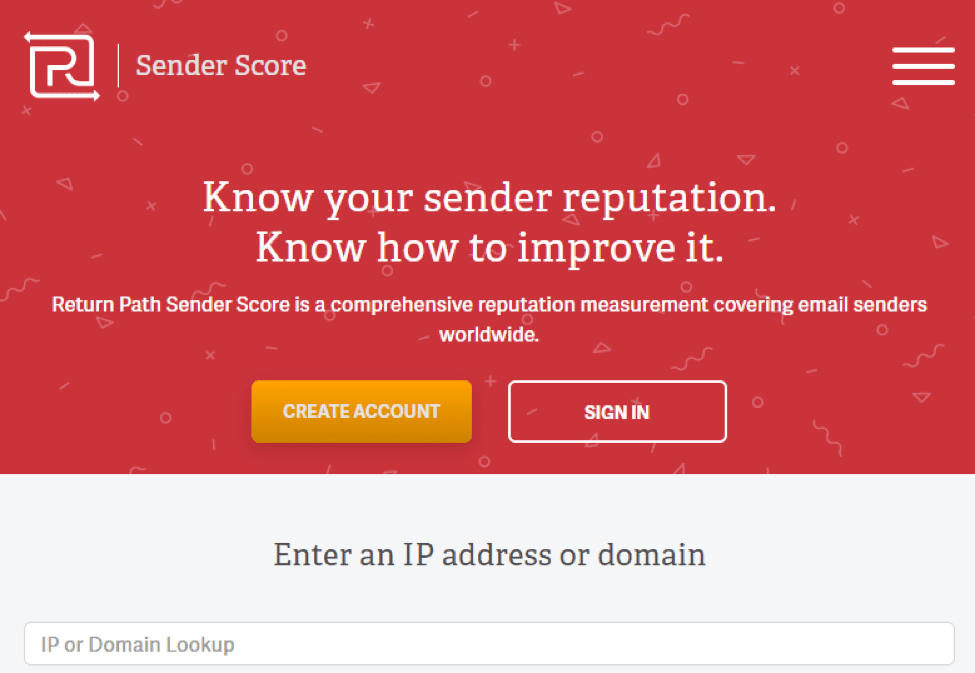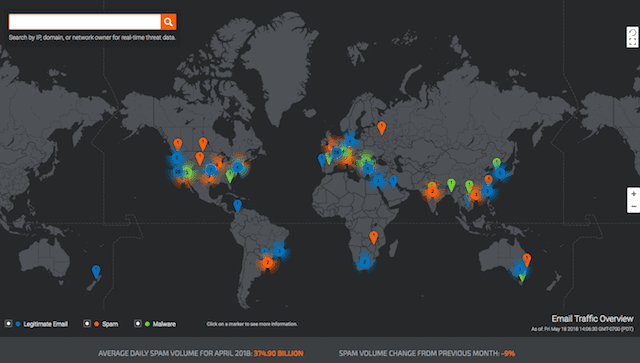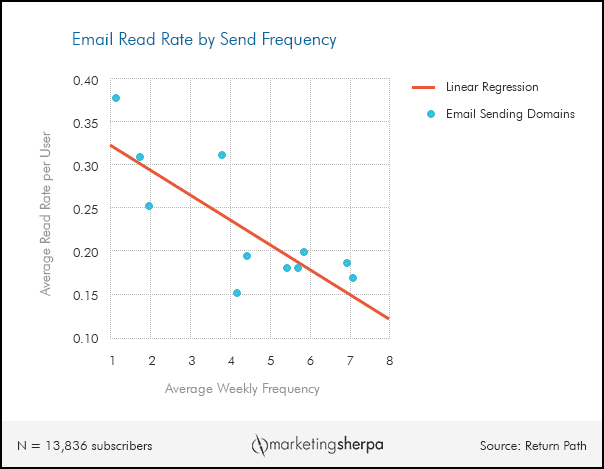

What is email sender reputation?
Sender reputation refers to the reputation of your email sending IP address that signals to email inbox providers whether or not you’re a spammer. It’s based on factors such as the content quality, quality of contacts, and engagement levels of previous emails sent from your IP address.
Mailbox providers like Gmail use your IP reputation — also known as email sender reputation, IP score, or sender score — to determine whether or not your email should be delivered to the inbox. If you want to make sure your emails don’t get sent to your contacts’ spam folders, the first step is avoiding common mistakes that damage the reputation of your sending IP address.
Experienced email marketers know that it’s not just about getting the job done. It’s about getting the job done right the first time. You don’t want to invest time crafting a beautiful, well-designed email campaign, hit send, and then have it land in the spam folder of your subscribers. This won’t generate revenue and will cause you to do double the work.
If you’re struggling with these issues, it means you probably need to work on improving your email deliverability, or the ability of your emails to reach the inbox. One of the main factors in determining email deliverability is the sender reputation of the IP address you use to send emails.
How email providers assess sender reputation
Email providers use algorithms to monitor the behavior and assess the risk potential of every IP address delivering messages to their network. These programs take certain factors and metrics into account to evaluate sender reputation. These include:
- Quality of contacts to whom that IP address is sending messages
- Level of engagement recipients show for emails from that IP address (open rate, click rate, unsubscribe rate, complaint rate, etc.)
- Sending volume trends
- Quality of content contained in the emails being sent by that IP address
Those are just a few examples among many other signals that email inbox providers look at when determining sender reputation and filtering for spam. Needless to say, you want to make sure the IP address you use to send emails has a good sender reputation.
One way to ensure a good sender reputation is to use a dedicated email marketing service like Sendinblue. We have a rigorous anti-spam policy in place and monitor sender reputation automatically to limit any potential deliverability issues.
2 Easy Ways to Check Your Email Sending IP Reputation
If you’re having deliverability issues, one of the first things you should investigate is your sender reputation. It’s also possible that you unknowingly sent emails in a way that is viewed as spammy by some email inbox providers. Or worse, maybe your IP has been put on an email blacklist.
Whatever the case, start by benchmarking where you are now. There are not many publicly available scores, but the tools below are a good starting point to measure your IP sender reputation.
1. Sender Score from Return Path


Return Path has come up with an email sender reputation metric called “sender score.” Your sender score is expressed as a number between 0 and 100, the higher the better.
What is Sender Score?
Email sender score is a metric comparable to a credit score, but instead of banks, you’re dealing with email providers. It sits on a scale of 1-100 and reflects the reputation of your IP, which is a factor in determining whether or not you’re filtered out as a spammer.
Much like a credit score, the sender score of your IP address can be easy to damage and tough to improve.
To put this in perspective, Return Path put together a 2019 Sender Score benchmark report, showing deliverability rates. Small changes in your score make big differences in your email deliverability. A score that drops from 83 down to 70 can see delivery rate decreasing by approximately 20%. This will lead to a huge loss of revenue.
To get a free assessment of your current Sender Score, just go over to SenderScore.org and plug in your IP address.
Just keep in mind that it’s just one company’s metric and not an industry standard. A lower sender score will have an impact on deliverability, but it’s not the sole indicator. Email services like Sendinblue have dedicated teams to maintain sender reputation and ensure deliverability for its clients. Thus, if you follow the best practices outlined later in this article, and use such a service, your email will land in the inbox every time.
2. Talos IP and Domain Reputation Center from Cisco
Talos Intelligence Group is part of Cisco and provides network security solutions for businesses. Similar to the previous two examples, Talos lets you look up your sender reputation by IP address for free on their website.


The results show you the IP reputation score for both web traffic and email of the IP address that you entered. Scores can be “Good,” “Neutral,” or “Poor.” There is also more detailed information about sending volume history and related sender IPs.
6 Common Mistakes Hurting Your Sender Reputation
Once you’ve checked your sender reputation using one or more of the methods mentioned above, you should know where your reputation stands with the email inbox providers.
If your IP sender reputation is lower than you would’ve hoped and you’re not sure why, it could be that you’re unintentionally sending the wrong signals to email providers by making common mistakes.
To help you avoid this moving forward, here are 6 common ways senders are damaging their sender reputation without even realizing it.
1. Collecting misspelled email addresses
It is so easy to collect invalid email addresses. On average 80% of invalid contact data is simply because of human error. Especially when people are using mobile devices.
People who respond to emails via mobile devices often have a funny “excuse my typo” phrase in their signature line. One of my favorites on this list is “Sent from a mobile device. Erroneous words are a feature, not a typo”. Let’s not forget about the viral autocorrect screenshots.
Source: runt-of-the-web
Sure, these things are funny, but when it comes to spending money to collect new leads and getting invalid results — there is nothing funny about that.
So how does this impact your sender reputation?
Hard bounces make up one of the largest portions of your sender reputation. If the email address you collected isn’t legit, email delivery is impossible. Most email service providers including Sendinblue will not tolerate a high hard bounce rate because you are damaging their IP reputation.
Read more: 11 Easy Ways to Decrease Your Email Bounce Rate
As a best practice, you should always set up a double opt-in authentication for new subscribers. Anyone who signs up receives an email asking them to click a link to confirm their subscription. This validation prevents misspelled addresses from being added to your email list.
You can also use a solution for real-time email verification to check the email address before you accept it into your marketing funnel. This way if the user has made an accidental typo they will see an error message. The user will now have a chance to correct their mistake before moving forward.
2. Using purchased email lists
Businesses often turn to data suppliers when they need new leads and new customers.
It sounds like an ‘easy choice’ because you will be able to quickly grow your list. However, the bad news is that you’re not growing your list organically. Working with data brokers will not help you improve your engagement rates and you shouldn’t buy email lists.
To have good email deliverability, and improve your sender reputation you need to have the users engage with your emails. This means they need to open and click the messages you send.
If you send to contacts you’ve acquired through a list broker, you will not have built up any trust with these users yet. What makes you think they’re going to engage? Open rates will most likely be abysmal and unsubscribe rates sky-high. Chances are they won’t, leaving you with a higher chance of being marked as spam.
Spam complaints are a big part of reducing your sender reputation. Each complaint you get is like sending a message directly to the internet service providers (ISPs) that their users do not trust your company.
If you get too many spam complaints with a specific ISP, they can choose to just push all of your emails directly to the spam folder. Imagine if all your Yahoo recipients never see your message from an email blast because Yahoo has decided to put you in the spam folder.
Further reading: Deliverability 101: How do email spam filters work?
3. Not cleaning your email list
Why are you keeping old data on your email list? It’s only costing you more money to keep uninterested contacts there.
As an email marketer, it is your responsibility to regularly remove unengaged users from your list. Users who are not opening or clicking on your content can lead to bigger problems that will damage your sender reputation.
For example, if a user has abandoned their email account, they aren’t opening your emails. This will later create a hard bounce. They also might not be active with your email content because they already moved you into the spam folder without your knowledge.
Cleaning your list is something you should be doing on a quarterly basis (if not more frequently). If you don’t feel ready to take the leap and delete a good portion of your contacts, learn how you can segment your list to achieve similar benefits.
Even if you do segment your list, it’s highly likely you still have contacts you haven’t emailed in several months. If this is the case, you should at least do a quarterly database clean-up to identify dormant email addresses that might generate a hard bounce.
4. Sending poor quality content
Never compromise quality for quantity. If you slap together a poorly created email campaign, users are much more likely to complain and unsubscribe. We already covered how spam complaints damage your sender reputation, and poor content gives them a reason to complain.
Things to keep in mind when creating your email content:
- Don’t use a bait and switch subject line. Here’s how to write email subject lines.
- Do pay attention to the email preview text as well.
- Don’t oversell to your users. Check out these 5 best practices for email CTAs.
- Optimize your email templates for mobile. See where you can find free responsive email templates.
- Don’t use spam words in your content. Find out more about email copy here.
- Test all of your links.
- Format your content for readability (see email design best practices).
5. Sending emails inconsistently
This is often overlooked by email marketers, but your email frequency matters when it comes to calculating your sender reputation.
You need some balance when creating your email campaign calendar. Email too often and you risk annoying your users and generating spam complaints. Email too little and you miss out on sales opportunities.
The bottom line is that if you don’t have a consistent schedule, and email random days and times of the week instead, your users may lose interest. Marketing Sherpa published a blog post around a study done by Return Path which claimed read rates declined as send frequency increased.
As a rule of thumb, it is best to stay focused. You want to set clear expectation with new subscribers up front. This way you can indicate how many times per week they should expect to hear from you. Here’s a study on the best time to send emails by industry.
Another thing you want to keep in mind when considering your volume frequency is how your subscriber list is growing. A quickly growing list or adding users in bulk to your ESP doesn’t look good. It give the appearance that you’re purchasing data and not following best practices.
6. Keeping spam traps on your email list
Spam traps threaten the good reputation of your email campaign. One rotten apple can bring down the whole tree.
The problem with traps is they can directly lead to getting blacklisted. Therefore, many marketers tend to jump ship from email platform to email platform because the black listings prevent their whole campaign from being delivered.
There are two main types of traps. Pristine traps are email addresses created by ESPs or blacklist organizers who post their email addresses across the web. Most of them get into your list because they were “scraped” or “harvested”. You might not directly be scraping data from the web, but you never know if one of your data suppliers has used these techniques.
The other type of trap is the recycled spam trap. These are email addresses that were once real but have been abandoned by the user. The ESP deactivates the account which should cause hard bounces for you so you remove the user from your list.
After the email address is inactive, the ESP reactivates the account many months later. If that account is still receiving emails from you, you will be blacklisted for not following best practices.
Boost Your Sender Reputation
In sum, here’s what you need to do to improve that sender reputation:
- Clean your list by regularly removing unengaged contacts
- Use double opt-in confirmation and/or an email verification tool to prevent misspelled addresses from winding up on your list
- Never buy contacts – always use lists that are 100% opt-in
- Stick to your promised frequency so subscribers know how many emails to expect – this reduces complaints
- Avoid spam trigger words and poor content – these will get flagged by spam filters
Improve your sender reputation with SendinblueEasy list segmentation and cleanup automation, A/B testing, beautiful email templates and double opt-in available. |
 Deutsch
Deutsch
























